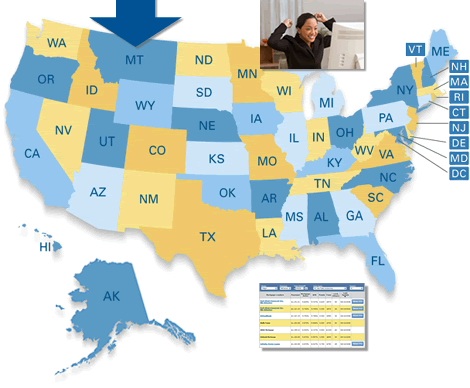Unlocking Savings: Calculating the Interest Drop for Refinancing Success
Mortgage refinancing can seem like a financial maze, but understanding its true essence could lead you to significant savings. Refinancing involves replacing your existing mortgage with a new loan, typically to capitalize on lower interest rates, shorten your loan term, or convert from an adjustable-rate to a fixed-rate mortgage. The allure of reduced monthly payments and long-term cost savings tempts many homeowners to navigate the refinancing waters. As we examine the intricacies of refinancing, we'll delve into how a dip in interest rates can be your golden ticket to minimizing mortgage payments and the pivotal factors that determine when refinancing truly pays off.
Understanding the Basics of Mortgage Refinancing
Refinancing your mortgage can be a strategic financial move, but it's important to grasp the fundamentals before diving in. Let's break down these essentials to help clarify when and why this option might benefit you.
Defining What Mortgage Refinancing Is
Mortgage refinancing involves replacing your current home loan with a new one, often with different terms. This process can lead to lower interest rates, different loan durations, or a change from an adjustable-rate mortgage to a fixed-rate mortgage. The ultimate goal is to achieve more favorable conditions that align with your financial objectives.
Explaining Why Homeowners Might Consider Refinancing
- Lower Interest Rates: Homeowners often refinance to benefit from lower interest rates, which can result in reduced monthly payments and overall interest costs.
- Equity Cash-out: Some homeowners may choose to refinance in order to access the equity in their home through a cash-out refinance.
- Loan Term Adjustments: Refinancing can also be used to modify the length of a mortgage, potentially shortening the term to pay off the home faster, or extending it to lower monthly payments.
The Impact of Interest Rates on Mortgage Payments
Interest rates are a critical factor in the cost of a mortgage. A lower interest rate can significantly decrease the amount you're required to pay each month and the total interest over the life of the loan. On the other hand, a higher rate means more money paid out over time. It's this potential savings that often motivates homeowners to consider refinancing when rates drop.
Analyzing Current Mortgage Interest Rates
When considering refinancing your mortgage, it's essential to look at the current mortgage interest rates to assess the potential benefits. As the financial market fluctuates, these rates can change frequently, impacting your decision. Let's delve into the latest figures and see what they mean for homeowners looking to refinance.
Presenting Data on the Current Average Mortgage Interest Rates
As of our latest update, the current average mortgage interest rates are as follows:
- 30-year fixed mortgage: 7.00%
- 15-year fixed mortgage: 6.52%
- 5/1 adjustable-rate mortgage: 6.44%
These rates are subject to change based on market conditions and should be used as a reference point for your refinancing considerations.
How the Current Rates Compare to Historical Averages
Historically, mortgage rates have experienced significant highs and lows. Comparatively, today's rates are insert assessment (e.g., relatively low, moderately high, etc.) when viewed against the backdrop of past decades. This historical perspective is crucial when determining the potential long-term savings of refinancing at current rates.
The Significance of Interest Rate Trends in the Decision to Refinance
Understanding interest rate trends is vital in your refinancing decision. A downward trend might suggest waiting for rates to drop further before refinancing, while an upward trend could indicate that locking in a rate soon may be advantageous. It's important to monitor these trends closely, along with economic indicators that could signify future rate changes. Working with a knowledgeable financial advisor or mortgage professional can provide further insight and guidance tailored to your individual situation.
The Importance of the Break-Even Point in Refinancing
When considering refinancing your mortgage, understanding the break-even point is crucial. This is the moment at which the costs associated with refinancing are equal to the savings you achieve from your new, lower interest rate. Determining the break-even point gives you a clear indication of when the decision to refinance starts to pay off financially.
What is a break-even point and how to calculate it?
The break-even point is essentially a financial calculation that helps homeowners ascertain when the cost of refinancing will be recuperated through the savings gained from a lower interest rate. To calculate it, you need to divide the total cost of the refinancing process by the monthly savings you expect from your new loan. This will give you the number of months it will take to recover your refinancing expenses.
The role of the break-even point in making the refinancing decision
Deciding whether or not to refinance is not only a question of if you can obtain a lower interest rate. It also depends on whether the potential savings justify the upfront costs. The break-even point is at the heart of this decision, as it indicates how long you need to stay in your current home to benefit from refinancing. If you plan to move before reaching the break-even point, refinancing may not be the most economical choice. Conversely, if you anticipate staying in your home well beyond that threshold, refinancing could be a financially savvy move.
- Consider the long-term benefits: If you reach your break-even point and continue living in your home, the savings can be significant over the life of your loan.
- Remember fluctuations: Mortgage rates can fluctuate, so understanding your break-even point helps you decide if it is better to refinance now or wait for potentially lower rates.
Understanding Closing Costs and Fees
Refinancing your mortgage comes with various closing costs and fees that can significantly influence whether the decision to refinance is financially beneficial. It's crucial to comprehend these expenses to assess the true worth of refinancing your home loan.
A Breakdown of Typical Closing Costs and Fees Involved in Refinancing
- Loan Origination Fee: This is the fee charged by the lender to process your new loan application. It typically ranges from 0.5% to 1.5% of the total loan amount.
- Appraisal Fee: An appraisal is often required to determine the current value of your home. The fee for this service can vary depending on the size and location of your property.
- Title Search and Insurance: These ensure the property title is clear of encumbrances and protect the lender's investment.
- Application Fee: This fee covers the administrative costs associated with your application.
- Attorney's Fees: In some cases, you may need to pay for legal services related to the closing.
- Prepayment Penalty: Check if your current mortgage includes a prepayment penalty for refinancing.
How These Affect the Overall Savings and Cost of Refinancing
Closing costs and fees need to be factored into your overall refinancing calculation to determine if the decision makes financial sense. These fees can add up to several thousand dollars, which means it's essential to calculate whether your savings from a lower interest rate will surpass these upfront costs over time. A general rule of thumb is that refinancing should reduce your interest rate by at least one percentage point to make it beneficial when considering these additional expenses. However, personal circumstances vary, and a detailed analysis of costs versus savings should be performed.
Understanding closing costs and fees is key to making an informed decision when considering mortgage refinancing. It's important to discuss all potential fees with your lender, and possibly negotiate some of them, to ensure that you achieve the anticipated financial benefits in the long run.
How Interest Rate Fluctuations Impact Refinancing
In the realm of homeownership, refinancing your mortgage can be a strategic move that leads to significant savings over time. However, the decision to refinance is closely tied to the fluctuations of interest rates. Navigating this landscape requires an understanding of how these changes can affect your potential refinancing outcomes.
The Relationship Between Interest Rate Fluctuations and Refinancing Outcomes
Interest rates are a critical factor in mortgage refinancing. Even a slight decrease in the rate can translate into reduced monthly payments and substantial savings on the total interest paid over the life of the loan. Conversely, if interest rates rise, refinancing may not yield the cost savings homeowners are seeking.
How Small Changes in Interest Rates Can Have Big Implications on Savings
A small change in interest rates might not seem significant at first glance, but when applied to a large loan balance over a lengthy period, the effect magnifies substantially. Here are a few points to consider:
- Monthly Payments: A lower interest rate means lower monthly payments, thereby improving your cash flow.
- Total Interest Over Loan Term: A smaller rate can mean tens of thousands of dollars in savings regarding total interest over the loan's term.
- Break-Even Point: Achieving the break-even point—where the savings exceed the costs of refinancing—happens sooner when the rate drop is substantial.
It's evident that even marginal interest rate fluctuation can make a notable difference in deciding whether or not to refinance your mortgage. Loan holders must keep a vigilant eye on the market trends to seize refinancing opportunities that align with their financial goals.
Calculating Potential Refinancing Savings
When considering refinancing your mortgage, it's crucial to understand how much you could potentially save. Careful calculation can reveal whether dropping interest rates sufficiently make refinancing a financially beneficial move. In this section, we'll explore the techniques to accurately estimate your savings by refinancing.
How to Use Refinancing Savings Calculations to Evaluate the Decision
Making an informed decision on refinancing hinges upon understanding the calculations behind potential savings. Evaluate your current mortgage terms against the proposed refinancing plan. Consider the new interest rate, term of the loan, and applicable closing costs. By doing so, you can determine how much you would save on a monthly basis and across the lifespan of your loan, which aids in identifying your break-even point—the time it takes for the savings to outweigh the costs.
Tools and Formulas for Estimating Possible Savings
To estimate your refinancing savings, you can use various financial tools and formulas:
- Refinancing calculators: These online tools can provide a quick glimpse into your potential savings and new monthly payment.
- Net Interest Savings: Calculate the difference between the interest paid on your current mortgage and the interest that would be paid on the new loan across equivalent time frames.
- Break-Even Analysis: Divide the total transaction costs by the monthly savings to find out how many months it will take to recoup the costs.
Remember, the true savings from refinancing come not from the nominal drop in interest rates but from the reduction in interest payments over the course of the loan. A professional assessment tailored to your specific situation will provide the most accurate savings estimate.
Home Equity and Loan-to-Value Ratio Considerations
When considering refinancing your mortgage, it’s imperative to understand the role of home equity and the loan-to-value (LTV) ratio. These two factors play a crucial role in determining your eligibility for refinancing as well as the terms and rates that lenders are willing to offer.
The Role of Home Equity in Refinancing
Home equity is the portion of your property that you truly own - it's the difference between the current market value of your house and the amount you owe on your mortgage. When you have substantial equity built up in your home, lenders may see you as a lower-risk borrower, which could lead to more favorable refinancing options.
What Loan-to-Value Ratio Means and Its Importance
The loan-to-value ratio is a metric used by lenders to assess the lending risk before approving a mortgage refinancing. To calculate the LTV ratio, divide the current mortgage balance by the home’s current market value. A lower LTV means more equity in the home and may qualify you for lower interest rates and better loan terms.
- An LTV ratio of 80% or lower is typically required to avoid private mortgage insurance (PMI).
- Some refinancing programs, like the Home Affordable Refinance Program (HARP), may allow for higher LTV ratios.
- Keep in mind that a high LTV ratio may result in less favorable terms or even disqualification from certain refinancing options.
Before proceeding with refinancing, evaluate these factors closely or speak with a qualified mortgage advisor to understand how your home equity and LTV ratio will impact the refinancing process.
The Impact of Your Credit Score on Refinancing
When considering whether to refinance your mortgage, it's pivotal to understand how your credit score could affect both the rates you're offered and the variety of refinancing options available to you. A higher credit score typically means more favorable loan terms, which could make refinancing a more economically advantageous decision.
How Credit Scores Affect Refinancing Rates and Options
Lenders use your credit score as a measure of your creditworthiness. It's a decisive factor that can significantly impact the interest rate provided by lenders. Generally, borrowers with higher credit scores will be eligible for lower mortgage rates, which might influence how much the mortgage interest needs to drop to make refinancing worthwhile. On the other hand, if your credit score has decreased since your original loan, you might find the available rates less appealing.
Tips for Improving Credit Scores Before Pursuing Refinancing
Improving your credit score can be a beneficial strategy before applying to refinance your mortgage. Here are some tips to help you enhance your credit profile:
- Pay Bills on Time: Ensure that you're making all your payments on time, as your payment history is a major component of credit scoring algorithms.
- Lower Your Credit Utilization: Try to pay down existing debts, especially on revolving credit accounts like credit cards, as a lower credit utilization ratio can improve your score.
- Correct Errors on Credit Reports: Regularly review your credit reports from the major bureaus and contest any inaccuracies you find.
- Avoid New Credit Inquiries: Each time you apply for credit, it can temporarily lower your score. If you're planning to refinance, avoid opening new accounts or making other moves that require a hard inquiry on your credit.
By taking these steps, you can potentially secure a lower interest rate when you refinance, which can make the process more cost-effective and help you reach your financial objectives more quickly.
Exploring Types of Refinancing Loans
When considering refinancing your mortgage, understanding the different types of refinancing options available to you is crucial. The right choice can significantly affect both your short-term and long-term financial planning, especially in relation to varying interest rates. Let's delve into the common types of refinancing and how they weigh against each other with regard to interest rate changes.
Comparison of Refinancing Loan Types
There are two primary kinds of refinancing loans that homeowners typically consider:
- Rate-and-Term Refinance: This type of loan allows borrowers to adjust either the interest rate, the term of the loan or both, without changing the loan amount. Its goal is usually to secure a lower interest rate or alter the length of the mortgage term to reflect your current financial situation better.
- Cash-Out Refinance: Unlike rate-and-term refinancing, a cash-out refinance permits the borrower to take out a portion of their home equity in cash. This strategy might lead to a slightly higher interest rate because it increases the loan amount and, potentially, the loan-to-value ratio.
Pros and Cons Relative to Interest Rate Changes
Each refinancing type reacts differently to shifts in mortgage interest rates:
Making the decision to refinance involves a comprehensive analysis of current interest rates, the potential benefits, and the specific conditions of each type of loan. Homeowners must consider their risk tolerance, financial objectives, and the costs associated with refinancing in the context of their unique financial situations to determine which refinancing option is optimal.
Timing and Market Trends in Refinancing
Refinancing a mortgage is not solely about securing a lower interest rate; it involves a broader understanding of the economic landscape and market trends. Knowing when to refinance can significantly affect the benefits you reap from the process. In this section, we explore the key factors that should influence your timing and how to make an informed decision based on market conditions.
Identifying the Best Time to Refinance
To determine the optimal moment to consider refinancing, it's crucial to monitor market trends. Interest rates are influenced by various economic factors including inflation, economic growth, and actions by the Federal Reserve. Tracking these trends can signal when rates are on the decline, suggesting a potential opportunity for refinancing. It's not just about a slight drop, but a decrease that is sufficient to cover closing costs and improve your financial situation over the term of your loan.
The Effect of Economic Indicators on Refinancing
Economic indicators are valuable tools for predicting future market behavior. Data such as employment reports, consumer confidence indexes, and gross domestic product (GDP) growth can provide insights into the direction of interest rates. Additionally, professional forecasts from financial institutions and analysts can shape expectations and influence your decision on when to refinance. Staying informed about these indicators can help you better understand and anticipate changes in refinancing viability.
- Inflation Rates: Higher inflation often leads to higher interest rates. If inflation is expected to rise, it might be wise to refinance before such an increase.
- Economic Growth: Strong economic growth can lead to higher interest rates as demand for credit increases. Refinancing during periods of economic expansion can preempt higher rates.
- Federal Reserve Policies: The Fed's monetary policy plans can significantly impact mortgage rates. Policy announcements can indicate the direction of short-term interest rates, thereby affecting long-term mortgage rates.
Aligning Refinancing with Financial Goals
Refinancing your mortgage can be a strategic financial decision. Yet, it's crucial to align this action with both your short-term and long-term financial objectives. The potential benefits of refinancing go beyond mere interest rate reductions; it's about how this decision fits into your overall financial plan.
Short-Term vs. Long-Term Financial Goals
When considering refinancing, determine how it correlates with your short-term financial goals. Are you looking to reduce your monthly payment to allocate funds to other investments or immediate needs? On the other hand, long-term financial goals might include paying off your mortgage faster or ultimately paying less interest over the life of the loan. It’s important to weigh the immediate benefits against the long-term outcomes to make a decision that's right for you.
How Refinancing Fits into Various Financial Strategies
Refinancing can serve diverse financial strategies, such as:
- Debt consolidation by using home equity to pay off high-interest debts.
- Reinvesting the monthly savings from a lower mortgage payment into retirement accounts or other investments.
- Adjusting your mortgage term to match your timeline for retirement, ensuring your home is paid off when you stop working.
However, it's imperative to consider the potential risks and costs associated with refinancing. Early payment penalties, closing costs, and other fees can offset the financial gains if not carefully evaluated. Therefore, align your refinancing decision with your comprehensive financial landscape to ensure it supports your end goals.
Tax Implications of Refinancing
When evaluating whether refinancing your mortgage will be financially beneficial, understanding the tax implications is crucial. Refinancing can alter your tax situation, and being aware of these changes can impact your decision-making process.
An Overview of How Refinancing Can Affect Taxes
Refinancing a mortgage may offer immediate financial relief in the form of lower monthly payments, but it can also lead to adjustments in the taxes you owe. Specifically, the interest paid on a refinanced mortgage remains tax-deductible, as with your original loan, but only up to a certain amount if the new loan exceeds the principal of your previous mortgage. Furthermore, if you tap into home equity and take cash out during refinancing, this could affect the deductibility of your mortgage interest as well.
Understanding Deductions and Tax Considerations Associated With Refinancing
One key factor to consider when refinancing is how it affects your mortgage interest deduction. While mortgage interest remains one of the more significant tax breaks for homeowners, limitations exist, especially post-tax reform. As of recent tax law changes, homeowners can deduct interest on up to $750,000 of qualified residence loans, a category that includes both primary and secondary homes but may be limited based on the date of the loan origination and other factors.
- Points Deduction: If you pay points to obtain a lower interest rate on your refinanced mortgage, you may be able to deduct these points, but generally over the life of the loan rather than immediately.
- Cash-out Refinancing Tax Implications: In a cash-out refinance, lenders typically allow homeowners to borrow more than they owe on their current loan. While the initial funds are not taxable, the IRS only allows you to deduct interest for the funds used to improve your home.
- Stricter Deduction Rules: The newer, more stringent tax laws may limit the deductibility of your mortgage interest, depending on the specifics of your refinancing and your individual tax situation.
It's essential to consult with a tax professional to understand fully how your particular refinancing scenario will interact with current tax laws. An expert can help you navigate the complexities of mortgage interest deductions and other considerations, ensuring you make informed choices that align with your financial objectives.
The Concept of Refinancing with Points
When homeowners consider refinancing their mortgage, one strategy that often arises is the purchase of discount points. Discount points, commonly known simply as 'points,' are a form of prepaid interest homeowners can opt to pay upfront to decrease the interest rate on their new mortgage. This can have a significant effect on the overall cost of refinancing and the long-term interest payments.
Explaining What Points Are and How They Can Affect Refinancing
One point is equal to one percent of the loan amount. Essentially, you are paying a portion of your interest at closing in exchange for a lower interest rate over the life of your loan. This upfront payment can be beneficial if you plan on staying in your home for a significant amount of time, as the savings from a lower interest rate can eventually outweigh the initial costs.
Calculating Whether Buying Points Makes Sense with Lowered Interest Rates
Deciding on whether or not to buy points hinges on a few key factors:
- Length of Time: How long you plan to stay in the property can determine whether the upfront cost is worthwhile.
- Interest Rate Reduction: The amount by which your interest rate is reduced when buying points.
- Savings Over Time: Comparing the lower monthly payments over time against the initial cost of buying points will show how long it takes to reach the break-even point.
Understanding the nuances of refinancing with points can be complex, but with a professional analysis, you could find significant savings on your mortgage over time. It's a decision that ultimately depends on individual financial situations and long-term homeownership plans. Consulting with a mortgage specialist can help determine the most financially beneficial route for your refinancing journey.
Choosing Between Adjustable-Rate and Fixed-Rate Mortgages in Refinancing
When considering refinancing, homeowners face a critical decision: the choice between an adjustable-rate mortgage (ARM) and a fixed-rate mortgage. This decision can profoundly impact your financial future and how beneficial refinancing will be in light of fluctuating interest rates.
The Difference Between Adjustable-Rate and Fixed-Rate Mortgages
- Adjustable-Rate Mortgages (ARMs): ARM loans begin with an introductory period offering a lower interest rate, after which the rate adjusts at predetermined intervals based on a benchmark interest rate.
- Fixed-Rate Mortgages: This type of mortgage locks in an interest rate for the entire term of the loan, offering consistent monthly payments and the security of a steady rate regardless of market changes.
Deciding Which Type Is Better in Light of Interest Rate Drops
When interest rates drop significantly, the advantages of each mortgage type can shift. If you're considering an ARM, you may benefit from a lower initial rate, which can be particularly appealing if you plan to sell or refinance again before rates adjust. On the other hand, a fixed-rate mortgage provides the security of knowing exactly what your payments will be over the life of the loan, which could be more advantageous if you're planning to stay in your home long-term or if the stability of your monthly mortgage payment is a priority.
Ultimately, the right choice will depend on your current financial situation, your long-term financial goals, and how much interest rates are predicted to change. It's essential to weigh your options carefully and consider how each type of mortgage aligns with your refinancing objectives.
When to Consult a Financial Advisor
Deciding to refinance your mortgage is a significant financial decision that can impact your finances for years to come. While many aspects of the refinancing process can be navigated independently, there are certain situations where seeking professional financial advice can be particularly valuable.
Situations Calling for Expert Financial Advice
Refinancing can become complex and some scenarios may warrant the expertise of a financial advisor, including:
- Understanding the long-term implications of refinancing on your financial health.
- Analyzing intricate tax repercussions related to mortgage interest deductions or loan forgiveness.
- Integrating your refinancing strategy with larger financial plans, such as retirement or education funding.
- Evaluating complex loan features, such as adjustable rates or the use of home equity.
Professional financial advisors can offer personalized insights tailored to your unique financial situation, ensuring that your decision to refinance is aligned with your overall financial goals.
Finding a Reputable Financial Advisor
To find a financial advisor with the right expertise in mortgage refinancing:
- Look for certifications such as Certified Financial Planner (CFP) or Chartered Financial Analyst (CFA).
- Choose someone with a fiduciary duty, committed to acting in your best interest.
- Seek recommendations from friends or family who have had a successful refinancing experience.
- Check their record with the Financial Industry Regulatory Authority (FINRA) or the Certified Financial Planner Board of Standards.
Ensure that any advisor you consider has a clear and transparent fee structure and a strong track record in mortgage refinancing consultancy. Making an informed choice can be the difference between a refinancing decision that benefits your finances and one that does not live up to your expectations.
Making the Smart Refinancing Decision
Refinancing your mortgage can be a promising financial move, but it hinges on a variety of factors, including the pivotal question—how much does the interest rate need to drop to make refinancing worth it? As we've explored, the decision isn't solely influenced by interest rates but also involves analyzing closing costs, your current financial situation, and long-term goals.
Key Takeaways for Interest Rate Reduction and Refinancing
- Understanding your break-even point is crucial to determine when you'll start saving money after covering the refinancing costs.
- The amount of interest rate drop required can vary based on closing costs, loan amount, and the potential duration of your mortgage.
- Refinancing can offer more than just interest savings—consider factors like home equity, credit score, and refinancing terms.
The Verdict on Mortgage Interest Rate Drops
No one-size-fits-all answer exists for everyone considering refinancing. Generally, a 1% to 2% drop in mortgage interest rates may signal that refinancing could be beneficial. However, conducting a personalized analysis of your unique situation is key to making an informed decision. Take into account the length of time you plan to stay in your home, potential savings over that period, and how much you can lower your monthly payments.
Embark on a Personalized Refinancing Evaluation
Before making the leap to refinance, review your current mortgage details against possible refinancing options. A methodical assessment, often with the assistance of a financial advisor, can illuminate the path that aligns best with your financial strategy. Whether it's to lower monthly payments, shorten the term of your loan, or tap into your home's equity for other investments, ensure that refinancing works to your advantage.
In conclusion, while understanding market trends and general guidelines is helpful, your refinancing journey should be tailored to your individual needs and goals. Assess not just how much the mortgage interest rates need to drop, but also how each piece of the refinancing puzzle fits into your financial picture. Taking these steps will help you make a refinancing decision that's both wise and beneficial for your future.
Credit Score Average for Cities
Fannie Mae & Jumbo Mortgage Rates
Just One Click! = Current Rate Chart

Start by selecting your state
Refinancing: Selecting a Loan

- Mortgage Program Options
- Interest Only Mortgage
- 100% Mortgage Financing - No Down Payment
- Mortgage Rates Comparison
- Search for Mortgage Rates
- No Costs Mortgage Refinancing
- 2% Rule - Refinancing Mortgage
- Yield Spread Premium
- Prepayment Penalty - Mortgage Refinancing
- What is APR and how is it calculated?
- Private Mortgage Insurance - Refinancing
Moving Ahead With Your Refinance
Get the Updated and Improved Mortgage Rates App from ERATE.com
FREE Mortgage Rate WidgetsYour State's Rates or National Rates Get this Widget for any State you want


